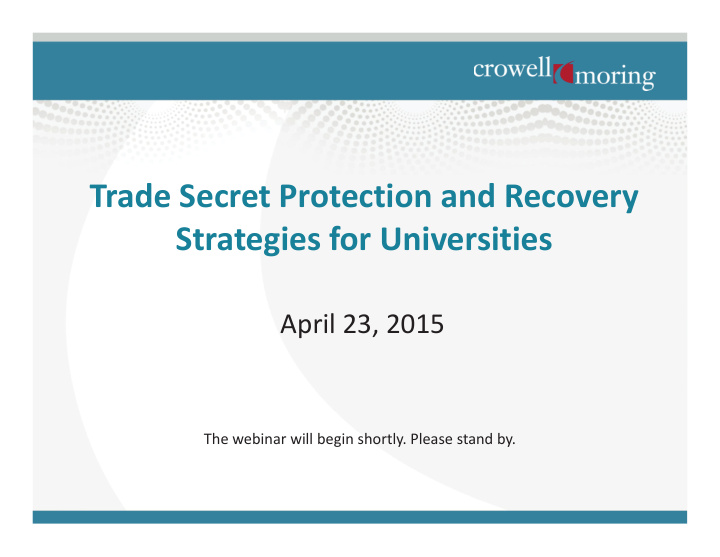



Trade Secret Protection and Recovery Strategies for Universities April 23, 2015 The webinar will begin shortly. Please stand by.
Today’s Presenters Michael Appel Mike Songer Mark Klapow 2
Today’s Discussion • Trends in trade secret law • Why should universities care? • Overview of trade secret law • Examples • Next steps for universities 3
Trends in Trade Secret Law • Technology theft is increasing – More competitive procurement environment – Increased use of (sub-)contractors – More joint ventures and joint research agreements – Increased hacking and cyber theft – Declining employee loyalty – Smaller storage devices – Myriad of state laws for enforcement 4
Why Should Universities Care? • Research • Past Experience • Agreements • Recovery Opportunities • Government Enforcement 5
ECONOMIC IMPACT • Losses caused by Trade Secret Theft – 1% - 3% of U.S. GDP (conservative estimate) – Between $167 and $503 billion Pricewaterhouse Coopers: Economic Impact of Trade Secret Theft (Feb. 2014). 6
Trade Secret Law • UTSA • CFAA • EEA • Federal Law? 7
What is a Trade Secret? 8
Legal Definition • A trade secret is: – Information, including a formula, a pattern, compilation, program, device, method, technique, or process, that: a. Derives independent economic value, actual or potential, from not being generally known to, and not being readily ascertainably by proper means by, other persons who can obtain economic value from its disclosure or use; and b. Is the subject of efforts that are reasonable under the circumstances to maintain its secrecy. 9
Reasonable Efforts – Considerations 10
Reasonable Efforts – Considerations 1. Policy 11
Reasonable Efforts – Considerations 2. Employees – on boarding – off boarding 12
Reasonable Efforts – Considerations 3. Security – physical – electronic 13
Reasonable Efforts – Considerations 4. Agreements 14
Reasonable Efforts – Considerations 5. Align efforts with value 15
Examples • We’ll start with a hypothetical… – Issue: new university professor – Challenges: lack of onboarding process, lack of policies, tenure – Take away: policies and procedures will likely help universities act swiftly in these situations 16
Examples • B & G Entm't, LLC v. Washington State Univ. – Issue: proposed concert ideas – trade secret? – Challenges: dealing with an overzealous plaintiff – Take away: documentation and testimony are important tools 17
Examples • Univ. of Connecticut v. Freedom of Info. Comm'n – Issues: • Public agency create and maintain trade secrets that are exempt from FOIA requests? • Customers lists – trade secrets? – Challenges: protecting sensitive information from disclosure – Take away: the trade secret definition is broad 18
Examples • Brigham Young Univ. v. Pfizer, Inc. – Issue: what is a protectable trade secret? A vision? – Challenges: dealing with and monitoring licensees – Take away: vigilant monitoring of trade secrets is important 19
What Should Universities Do? • Understand… – What information you have – Is it a “trade secret” • Not everything is a trade secret, even if it is not known – The realities of “identification” – Risk allocation – Sources for disclosure • The special problem of academic publications 20
What Should Universities Do? • Establish policies and procedures – Identifying trade secret theft – Reporting chain – Providing the ability to act decisively and quickly – Balancing legal risks versus realities of the University workplace 21
Questions? 22
Citations • Uniform Trade Secrets Act • B & G Entm't, LLC v. Washington State Univ. , 159 Wash. App. 1016 (2011) • Univ. of Connecticut v. Freedom of Info. Comm'n , 303 Conn. 724, 726 (2012) • Brigham Young Univ. v. Pfizer, Inc. , 861 F. Supp. 2d 1320 (D. Utah 2012) 23
Contacts Mike Songer Mark Klapow Michael Appel msonger@crowell.com mklapow@crowell.com mappel@crowell.com 202.624.2990 202.624.2975 202.624.2582 24
Recommend
More recommend